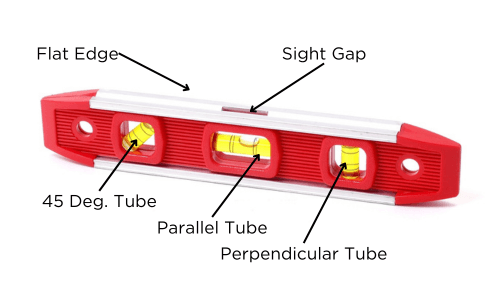Bubble (Torpedo) Level
Anatomy of a Bubble Level

What is a Bubble Level?
Who would use a Bubble Level?
What should you consider when selecting a bubble level for you?
When selecting a bubble level, consider the following factors to ensure you choose the right one for your needs:
-
Length and Size: Bubble levels come in various lengths, from small pocket sizes for quick checks to longer ones for more extensive and precise work. The length should match the size of the projects you typically undertake.
-
Material: Levels are made from different materials, such as plastic, aluminum, and wood. Aluminum levels are durable and lightweight, making them a popular choice for professional use, while plastic levels might be suitable for light, occasional use.
-
Accuracy: The accuracy of a level is crucial, especially for tasks requiring high precision. Check the manufacturer’s specifications for accuracy, usually stated in terms of mm/m (millimeters per meter) or inches per foot.
-
Number and Orientation of Vials: More vials allow for greater versatility. Ensure the level has at least one vial for horizontal (level) measurements and one for vertical (plumb) measurements. Some levels also include a 45-degree vial for diagonal measurements.
-
Vial Visibility: The ease of reading the vial is important. Look for levels with clear vials and high-contrast markings for easy visibility, even in low light conditions.
-
Magnetic or Non-Magnetic: Magnetic levels can be very handy when working with metal surfaces as they stick to the surface, allowing hands-free use. Non-magnetic levels are better suited for other materials.
-
Durability: The construction of the level should withstand the work environment. For heavy-duty use, look for levels with shock-absorbing end caps and solid construction to resist bending or breaking.
-
Features: Some levels come with additional features such as laser guides, digital readouts, or illuminated vials for use in dark areas. Consider which features might enhance your work efficiency.
-
Brand and Warranty: Reputable brands often guarantee a higher level of quality and reliability. A good warranty can also provide peace of mind and protection against defects.
-
Price: While it’s important to invest in a quality tool, ensure the price aligns with your budget and the level of use it will get. Sometimes, a mid-range level is sufficient for occasional DIY projects, whereas professional tasks may require a higher-end model.
Safety Precautions with Bubble Levels!
ToolFinder Recommends

CRAFTSMAN Torpedo Level, Magnetic, 9 inch (CMHT43191)
For a smaller 9″ bubble level for simple applications, check out this CRAFTSMAN Torpedo Level, Magnetic, 9 inch (CMHT43191)

WORKPRO 3-Piece Spirit Level Set (12", 20", 40"), Level Set with Magnetic Torpedo Level, 45°/90°/180°Bubbles Measuring, Open Top View Design, Aluminium Alloy Levels with Carrying Bag
If you’re looking for a set of different sized levels, check out this WORKPRO 3-Piece Spirit Level Set (12″, 20″, 40″), Level Set with Magnetic Torpedo Level, 45°/90°/180°Bubbles Measuring, Open Top View Design, Aluminium Alloy Levels with Carrying Bag